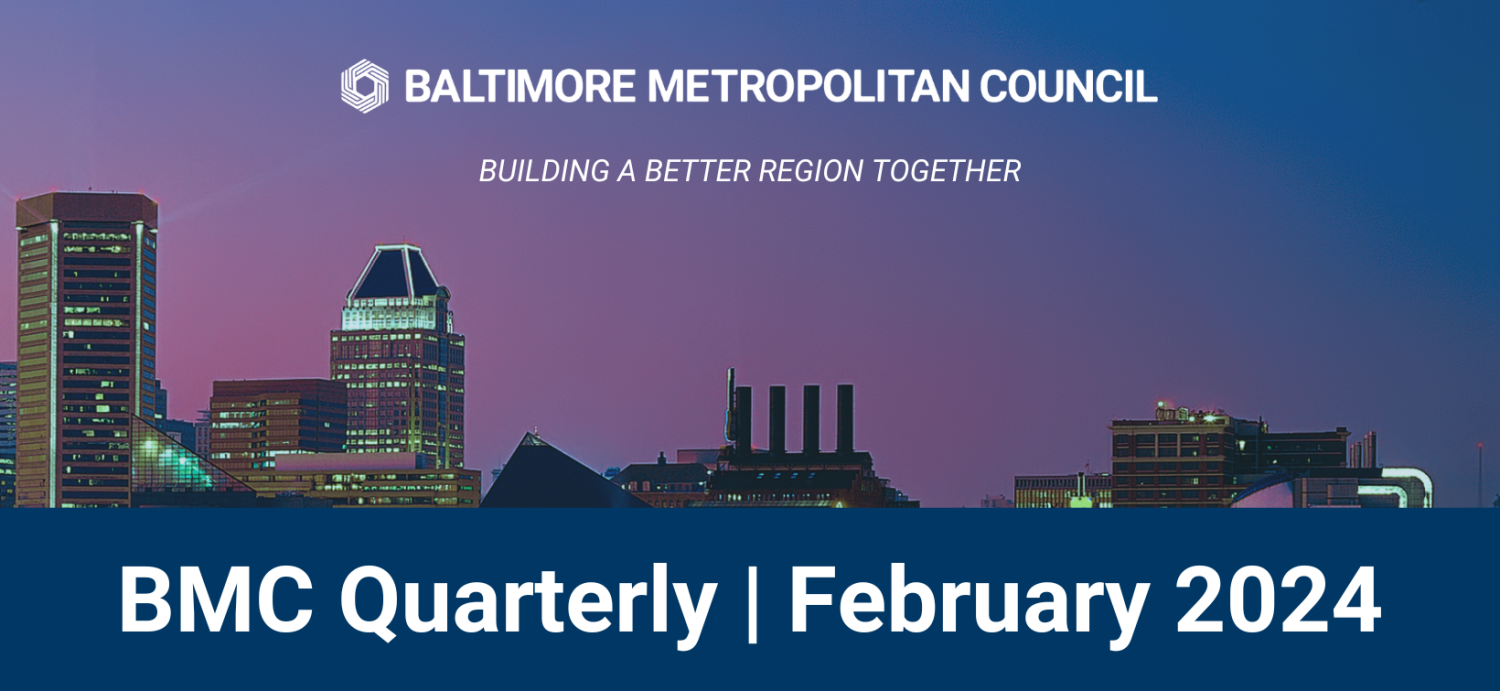
FROM OUR EXECUTIVE DIRECTOR
Thank you for reading BMC Quarterly, a brief overview of the Baltimore Metropolitan Council’s activities and initiatives to keep you in the loop.
We had a busy summer at BMC. Our team has worked to develop a Comprehensive Climate Action plan, a regional strategy for reducing pollution and pursuing sustainability. We worked with the Maryland Transit Administration to host the Baltimore Regional Transit Commission for site visits. Meanwhile, the Baltimore Regional Transportation Board approved a $4.52 billion Transportation Improvement Program and $18.8 million in grant funding for transportation projects and achieved federal certification. The Cooperative Purchasing Committee’s Energy Board secured $29.2 in savings on electricity spending.
This is just a snapshot of some of our recent work. We are proud to continue building a better region together, and I am grateful to our staff and partners for taking on this work. I hope you’ll read on to learn more about our programs.
Sincerely,
Mike Kelly
Executive Director
Baltimore Metropolitan Council
TOP STORY
Comprehensive Climate Action Plan
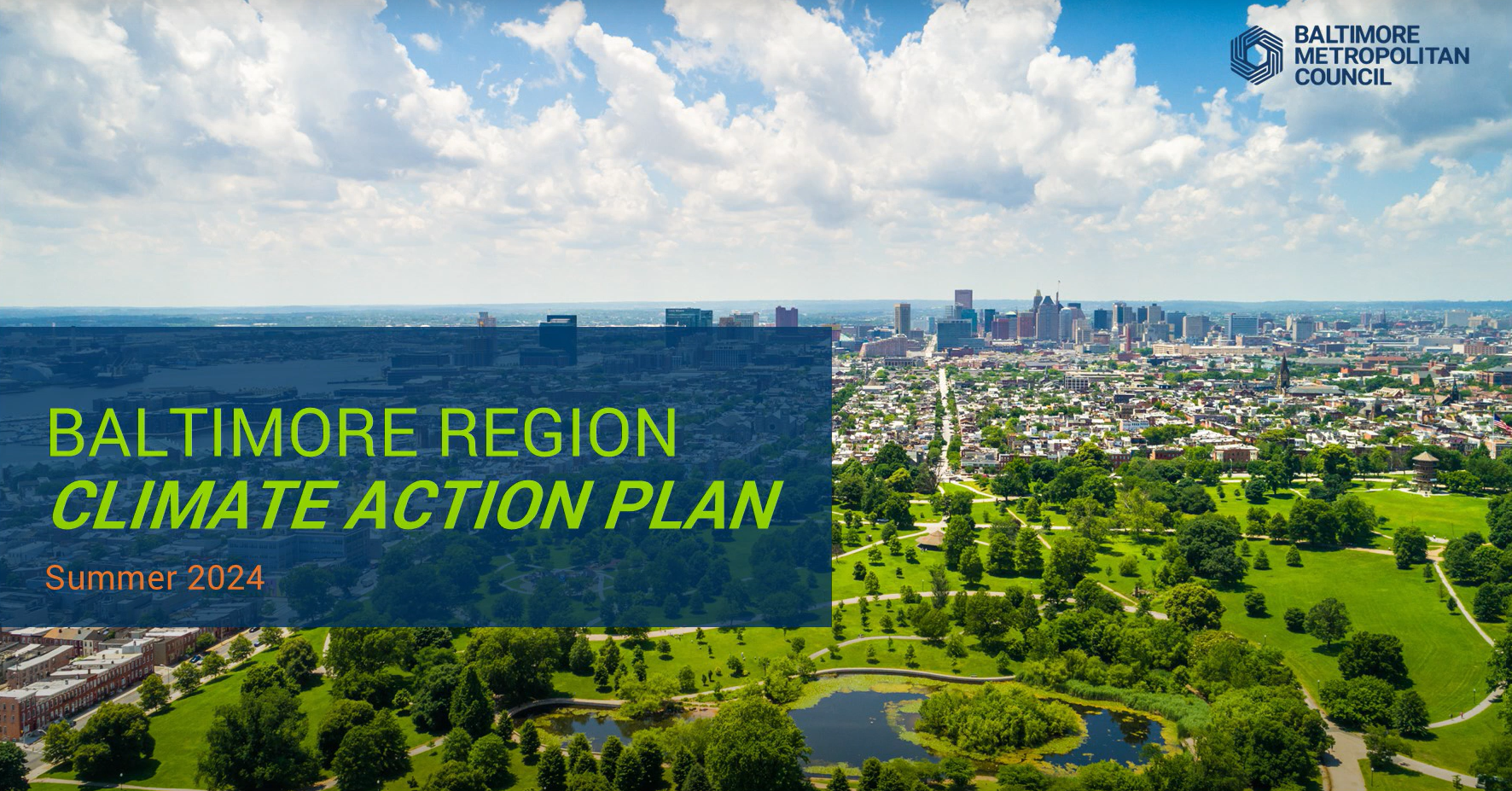
We are developing our Comprehensive Climate Action Plan (CCAP), a strategy shaping future climate action in the region. Funded by the U.S. Environmental Protection Agency’s Climate Pollution Reduction Grants program, the CCAP seeks to inform and coordinate action from local and state agencies toward reducing pollution and ensuring a more sustainable future.
Residents throughout the region are invited to complete a brief survey to weigh in on issues related to the CCAP. This feedback will inform additional planning efforts later this year and next year, and help local jurisdictions respond to the unique challenges and opportunities in their communities. The project team will also host community meetings for you to learn more, ask questions and share your thoughts.
“We want to make sure that the plan not only addresses environmental issues but also reflects the needs and values of our region’s residents,” said Executive Director Mike Kelly. “We encourage everyone to join us in advancing climate action.”
Learn more at publicinput.com/climateplan.
IN OTHER NEWS
BRTC Transit Tours

Over the summer, the Maryland Transit Administration hosted members of the Baltimore Regional Transit Commission at its Kirk Avenue Bus Maintenance Facility and Operations Control Center to learn more about what it takes to run the region’s bus, light rail and metro systems. The tour included a briefing on the new zero-emission buses joining the fleet thanks, in part, to funding approved by our Baltimore Regional Transportation Board.
The Commission reconvened earlier this month after a summer recess, and will next meet on Friday, October 4.
BRTB Funding Approvals
The Baltimore Regional Transportation Board (BRTB) recently approved nearly $18.8 million in Federal Highway Administration (FHWA) grant funding for 18 carbon reduction and alternative transportation projects.
Of the approved funding, $14.1 million from the FHWA’s Carbon Reduction Program will go toward projects such as energy-efficient streetlights, electric vehicle fleet upgrades and charging, improved traffic management and zero-emission buses. Meanwhile, $4.7 million from the FHWA’s Transportation Alternatives Set-Aside Program will go toward targeted projects to design or implement improvements to bicycle and pedestrian facilities, including crosswalks, sidewalks, bike lanes and shared-use paths.
Housing Hot Spots
Sites in Ten Hills, Edgewood, and South Baltimore are emerging as the ‘hot spots’ for residential development in the Baltimore region, according to our latest Residential Building Permit Activity Hot Spot Report. In 2023, 7,298 residential units were permitted in the Baltimore region. This data can help the region’s leaders evaluate trends and implications for the region’s opportunities for wealth-building, homeownership and transportation.
Federal Certification

The BRTB recently achieved certification from the Federal Highway Administration and Federal Transit Administration. The process of federal certification takes place every four years and seeks to ensure that the BRTB follows federal rules for planning and outreach. Since the BRTB’s previous certification in 2020, more than 1,750 people weighed in on plans and projects, helping shape the future of the region’s transportation system. The BRTB continues striving to reach more people around the region and bring more voices into the planning process.
BOARD UPDATE
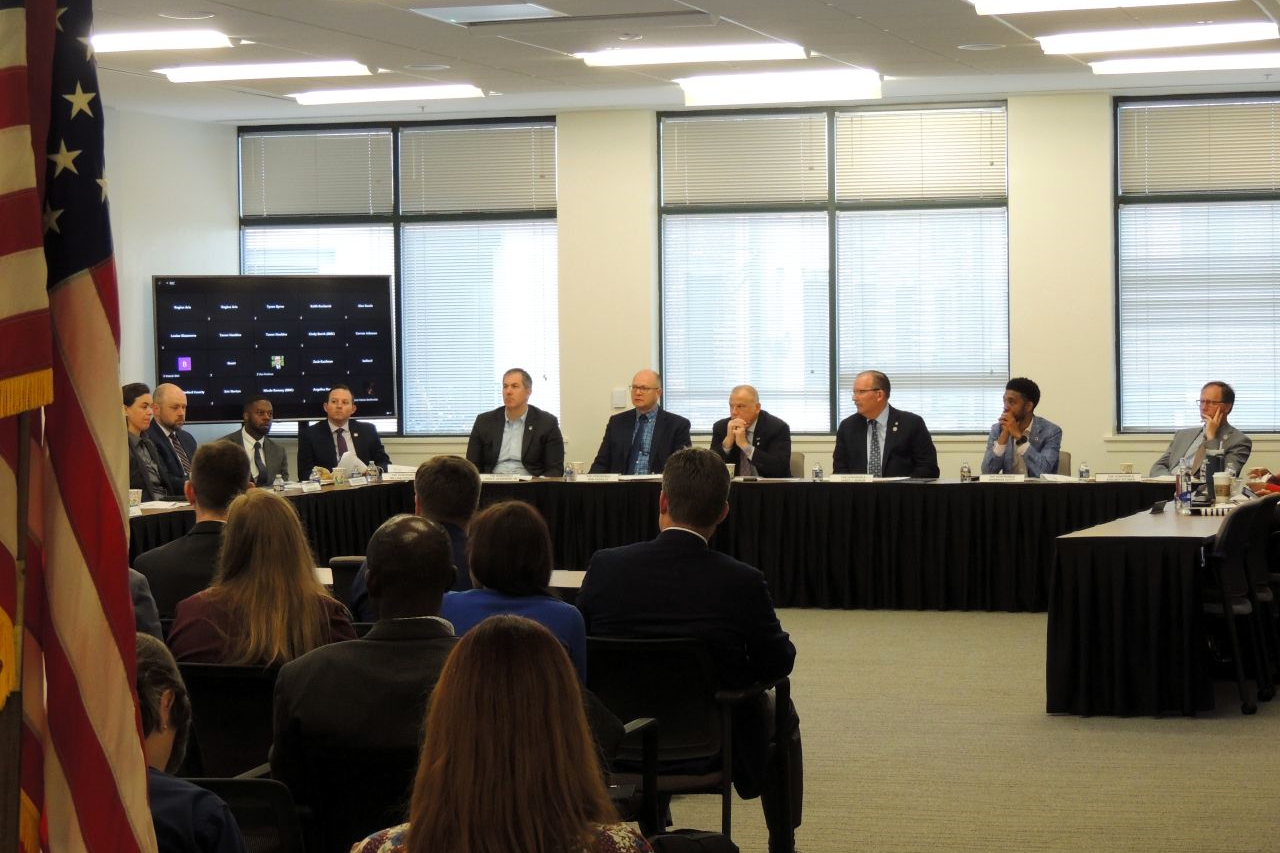
Our board members received a briefing from the U.S. Coast Guard representatives of the Key Bridge Response Unified Command on the Key Bridge collapse response. The discussion included how we can help our communities recover from the disaster as Maryland works toward rebuilding.
Our Board of Directors will next meet on Friday, October 25.
ENGAGEMENT OPPORTUNITIES
Bikeable Baltimore Region
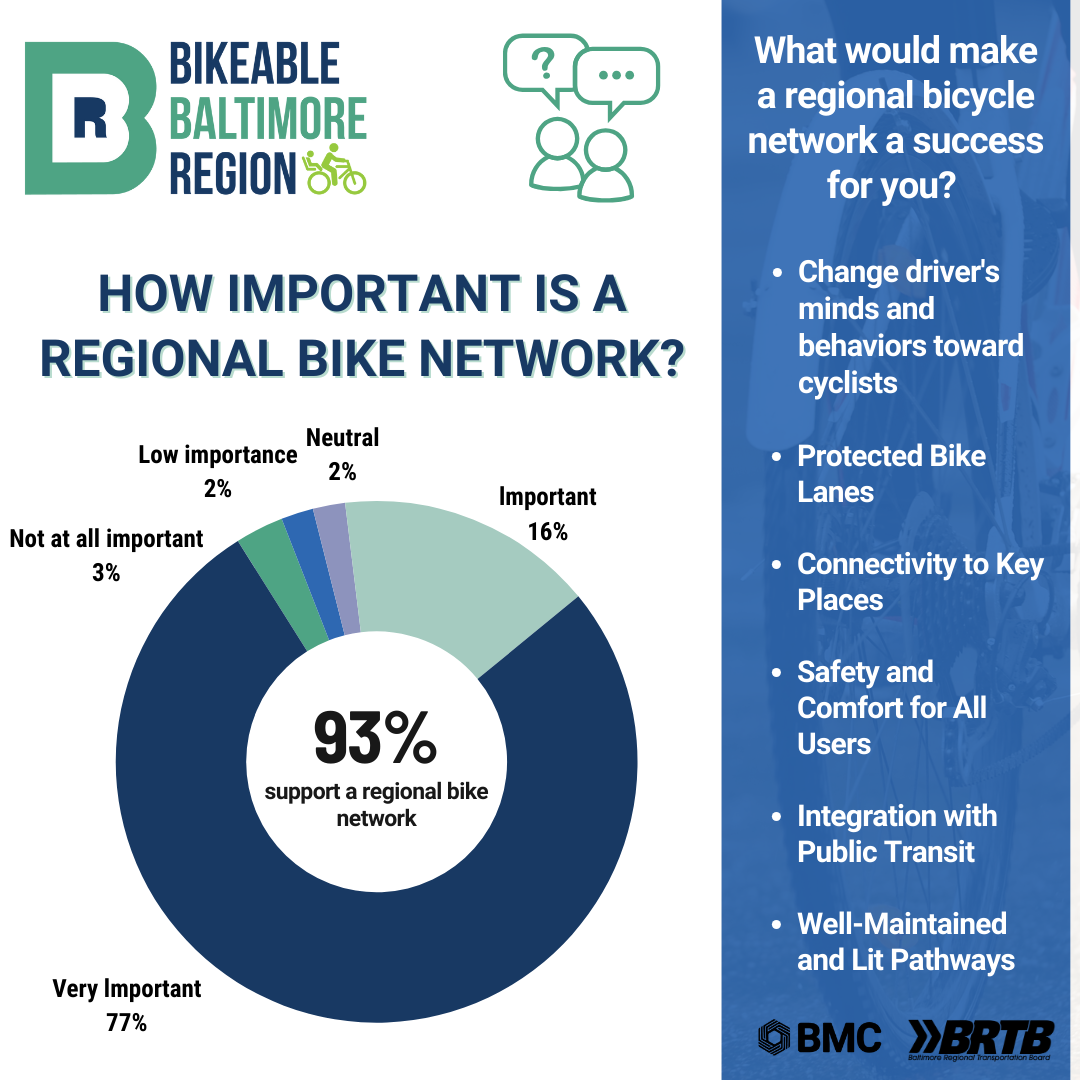
Our Bikeable Baltimore Region project seeks to identify challenges and opportunities in creating the first comprehensive regional bike network. The project does not budget for construction, but will simply identify existing, planned and potential bike facilities that are safe and comfortable for people of all ages, laying the groundwork to connect local communities and provide safe access to transit, schools, work, parks and other destinations.
The initial public comment period was held from May to July, including ten public meetings around the region. Another comment period inviting the public to weigh in on more detailed analysis and plans will open later this year. Learn more and get updates at publicinput.com/BikeBaltoRegion.
Patapsco Regional Greenway: Stoney Run
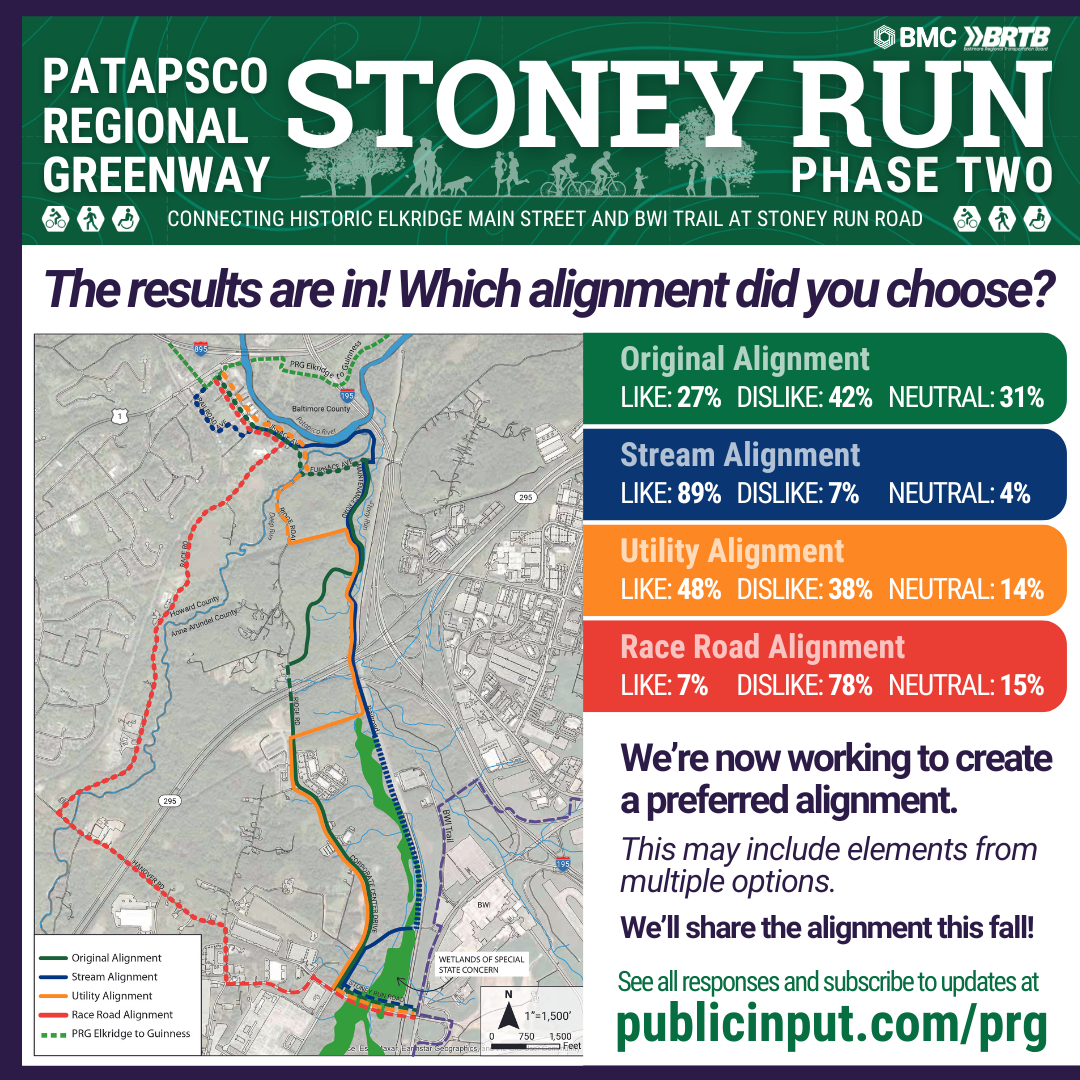
Progress continues on the Patapsco Regional Greenway initiative, which seeks to connect Baltimore’s Inner Harbor with Sykesville in Carroll County via a 40-mile trail network in the Patapsco River valley. This year, we focused on a segment connecting Elkridge Main Street with the BWI Trail at Stoney Run Road.
We shared an initial survey to gather public feedback on the proposed trail and found that 97 percent of over 100 respondents supported the project. During the summer, we hosted a comment period to present four variations of the proposed trail route. From this feedback and our team’s technical analysis, we’re now developing a final proposed route, which we will share with a final comment period later this year before passing along the design plans to agencies in Howard and Baltimore Counties for implementation.
Learn more and subscribe for updates on the project via publicinput.com/prg.
PROGRAM SPOTLIGHT: ENERGY BOARD SAVES $29.2 MILLION IN FY24
The Energy Board, a subcommittee of our Cooperative Purchasing Committee, saved $29.2 million on electricity in the previous fiscal year, bringing its cumulative savings since inception in 2006 to approximately $319 million. As the Energy Board oversees energy procurement for participants, including city and county governments, public schools and community colleges, the savings free up taxpayer money for other investments.
Learn more about the Energy Board at baltometro.org/purchasing/committees/energy-board.
UPCOMING MEETINGS
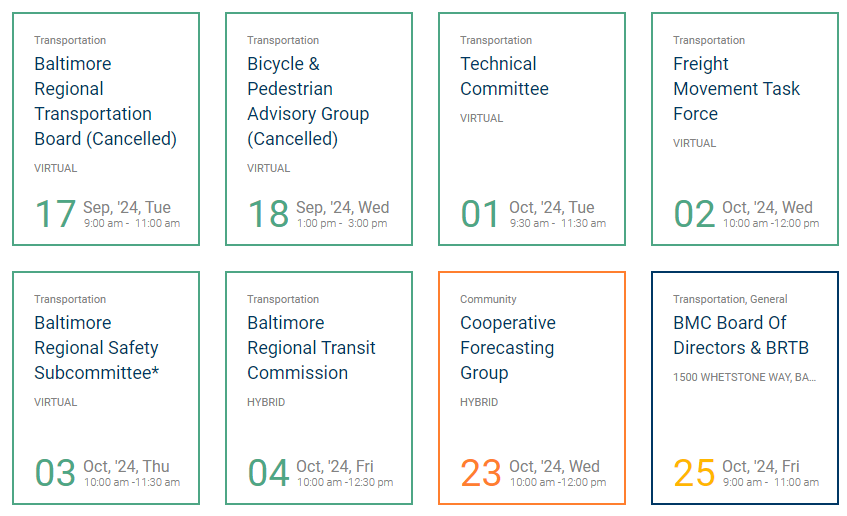
Thanks for reading this edition of BMC Quarterly. Click here to subscribe to future editions.
#
Baltimore Metropolitan Council (BMC) works collaboratively with the chief elected officials in the region to create initiatives to improve quality of life and economic vitality. As the Baltimore region’s council of governments, BMC hosts the Baltimore Regional Transportation Board (BRTB) and supports local government by coordinating efforts in a range of policy areas including emergency preparedness, housing, cooperative purchasing, environmental planning and workforce development.

FROM OUR EXECUTIVE DIRECTOR
Thank you for reading BMC Quarterly, a brief overview of the Baltimore Metropolitan Council’s activities and initiatives to keep you in the loop.
It has already been a busy year at BMC. We recently hosted the first meeting of the Baltimore Regional Transit Commission, which will seek to provide long-overdue oversight and advocacy for greater Baltimore’s public transit system. We welcomed a new Board of Directors Chair in Queen Anne’s County Commissioner Jim Moran, and new Vice Chair in Anne Arundel County Executive Steuart Pittman. We are working on several transportation planning projects and preparing to roll out more. And speaking of rolling out, our annual Bike to Work Central Maryland program is set for the week of May 13.
With all this and more, it’s a packed issue of BMC Quarterly, and it’s looking likely to be a packed year of programs for our agency. As always, I’m proud of the work we do, and our amazing staff who make it happen. I hope you’ll read on to find out more about what we’re up to, and that you won’t hesitate to reach out to us with any questions or comments about our agency’s activities. We would love to hear from you.
Sincerely,
Mike Kelly
Executive Director
Baltimore Metropolitan Council
TOP STORY
Baltimore Regional Transit Commission
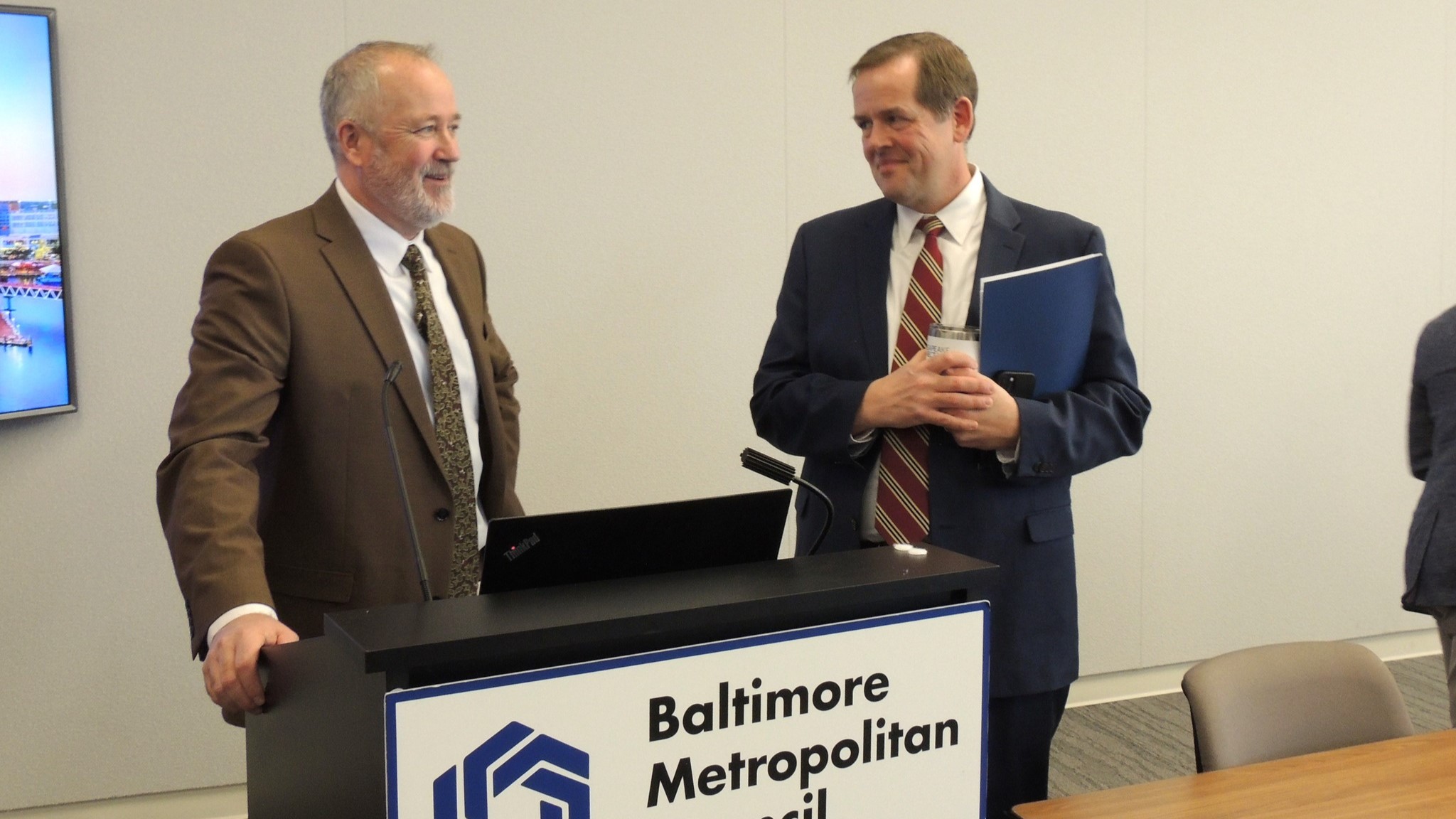
We were honored to host the Baltimore Regional Transit Commission (BRTC) for its inaugural meeting on Friday, February 2.
Created by the Maryland General Assembly in the 2023 legislative session, the Commission will work to identify and prioritize local and regional transit needs, and begin laying the groundwork for a new future of transit governance in the region. The Commission will engage state partners at the Maryland Transit Administration (MTA), as well as Locally-Operated Transit Systems and transportation planning professionals, to pursue an ambitious vision of oversight and advocacy.
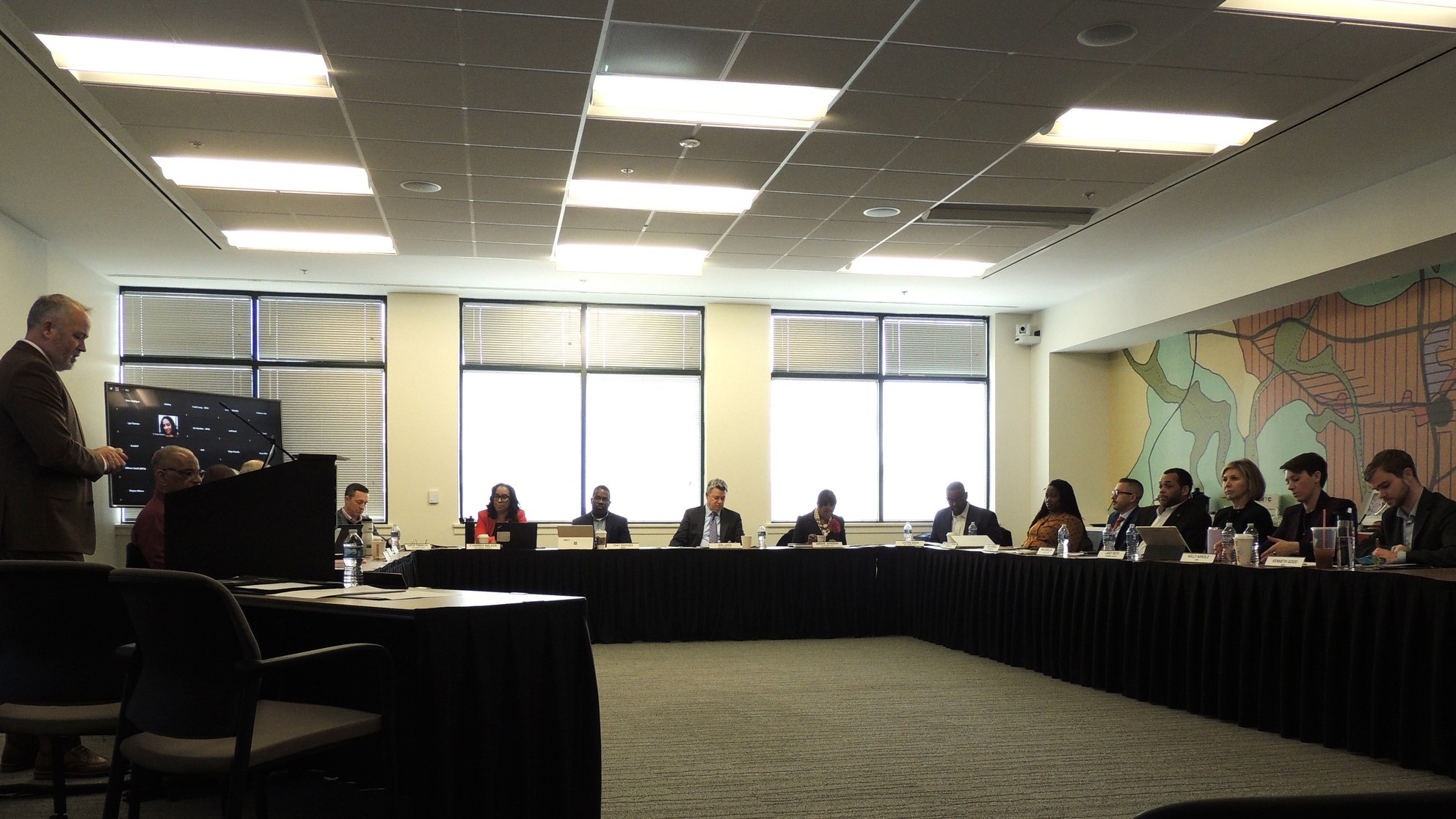
The Commissioners, appointed by Governor Wes Moore, Baltimore City Mayor Brandon Scott, Baltimore County Executive John Olszewski, Jr., Anne Arundel County Executive Steuart Pittman and Howard County Executive Calvin Ball, represent transit riders, employers, industry experts and others with a stake in improving greater Baltimore’s transit networks. BRTC members elected Baltimore attorney Jon Laria as Chair.
In their first meeting, Commissioners heard from MTA Administrator Holly Arnold and deputies, as well as our staff supporting the work of the BRTC, to learn more about the challenges facing transit in the Baltimore region, and the work underway to overcome those challenges. In future meetings, the Commission will begin to develop a forward-looking work plan.
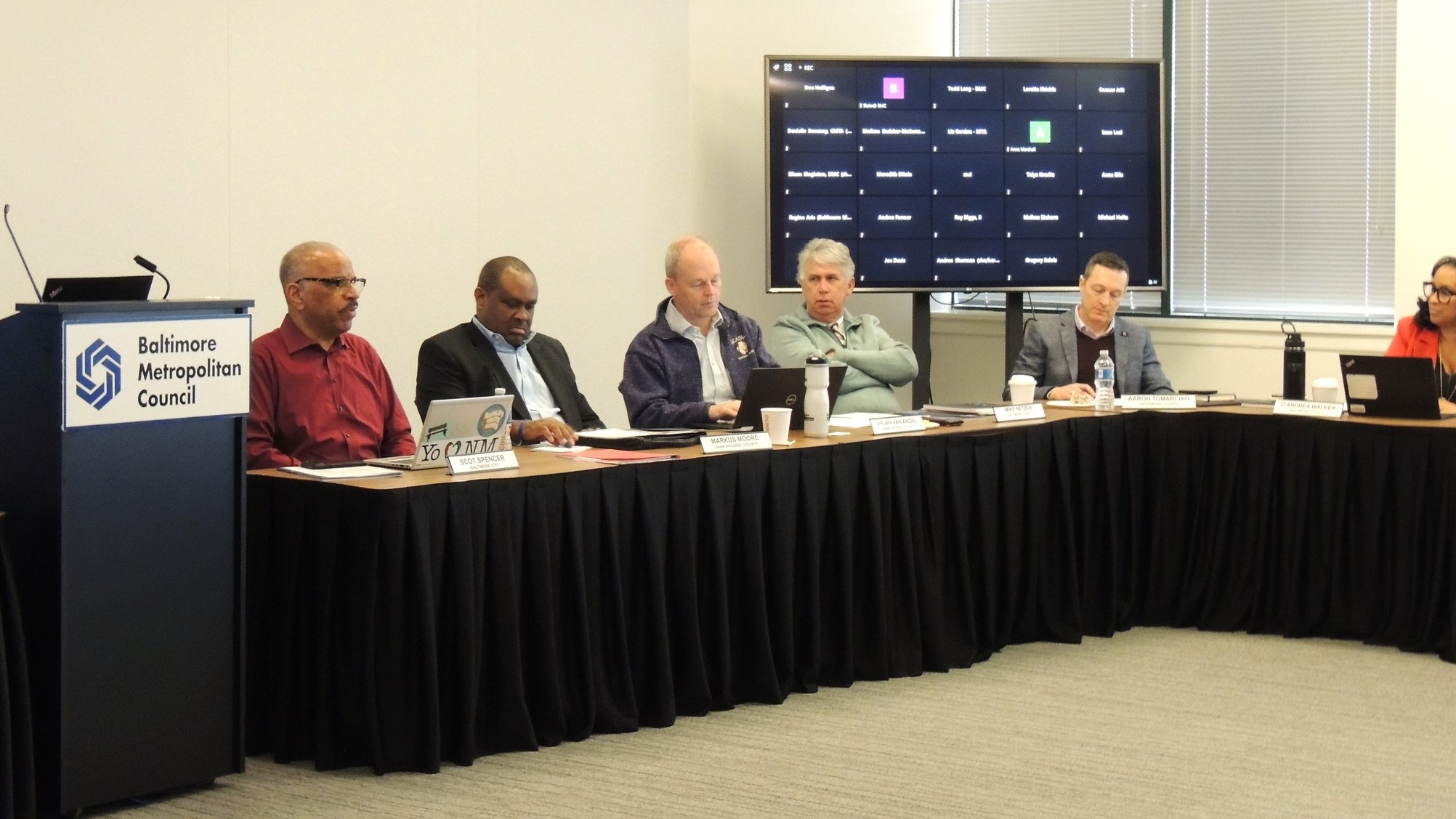
The next BRTC meeting is set for Friday, March 8 at 10 a.m. Members of the public are welcome to join virtually or in-person.
IN OTHER NEWS
GoSmart Maryland Commuter Resource
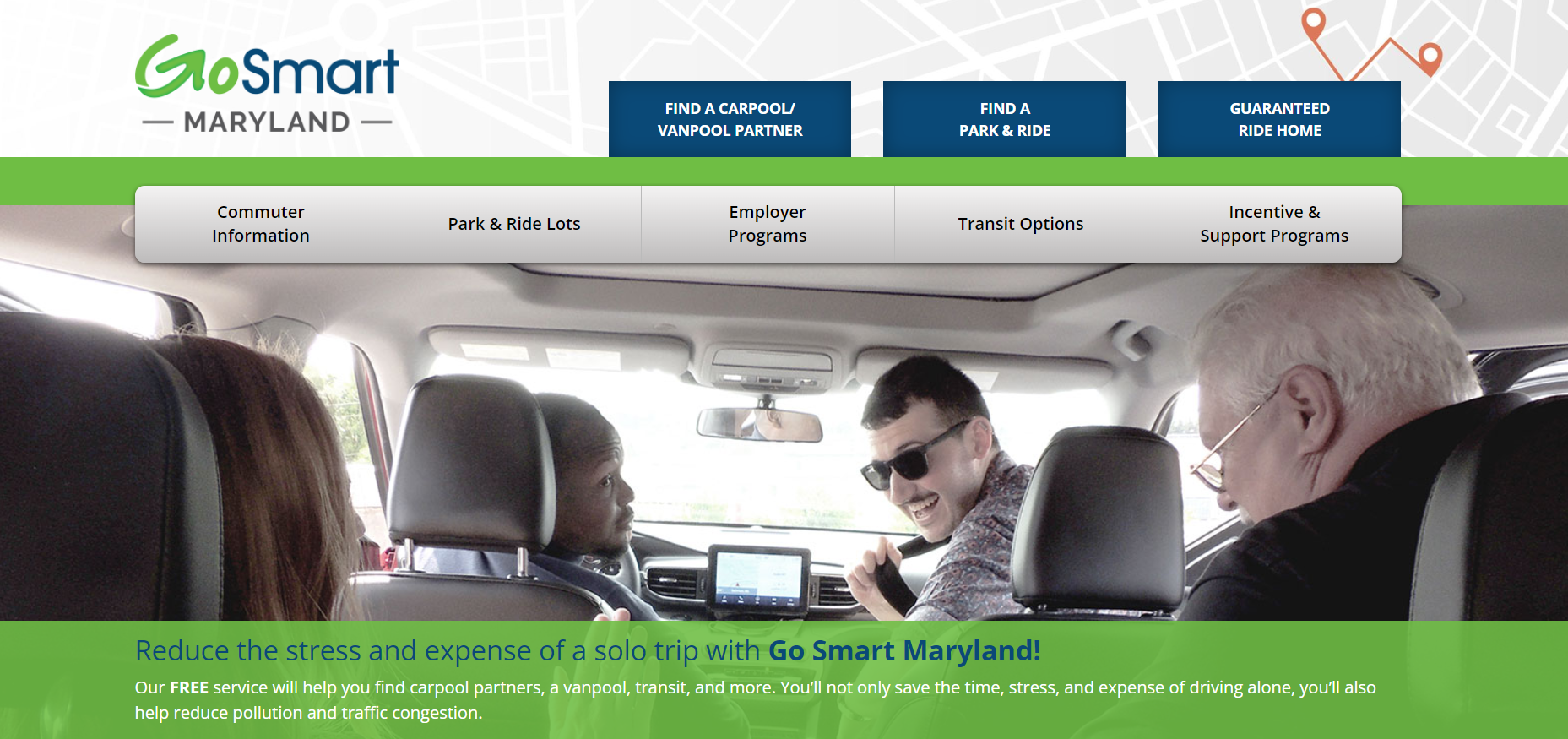
We recently launched launched GoSmart Maryland, a new platform providing residents of Baltimore and Carroll counties with easy access to information on carpool and transit options, as well as programs that offer car-poolers, cyclists and transit riders a free ride home in an emergency and financial incentives for ditching cars.
GoSmart Maryland offers a free service to help businesses provide free and low-cost transportation benefits that help employers and employees save money, reduce stress and benefit the environment. GoSmart Maryland can help businesses find programs that help recruit and retain top talent, achieve sustainability goals, save on payroll taxes and secure free benefits for workers. Free programs include employees pre-tax benefits, employ subsidies and the guaranteed ride home benefit.
Learn more at gosmartmd.com.
Regional Bulk Purchasing Contract Database
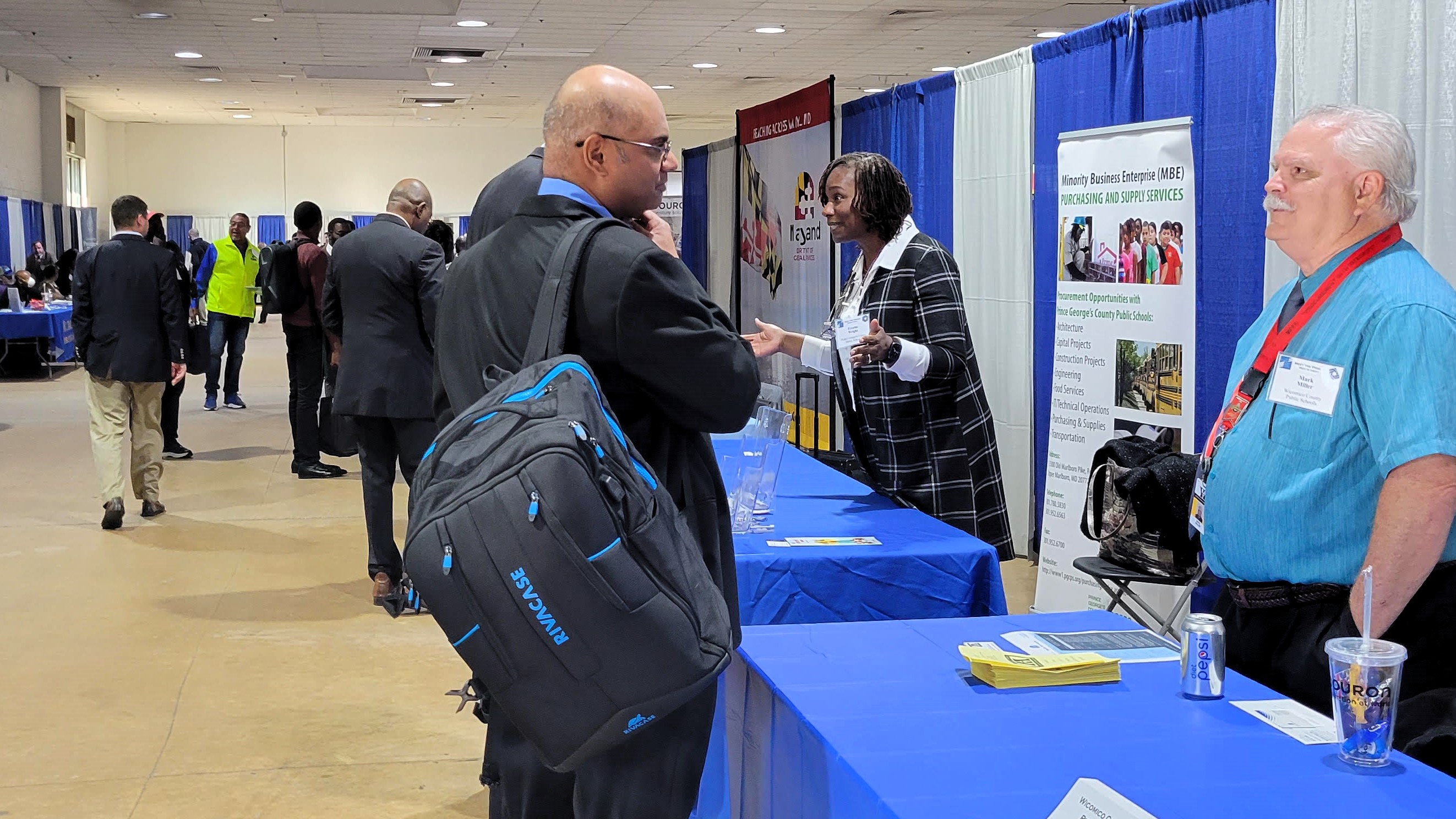
The Baltimore Regional Cooperative Purchasing Committee (BRCPC) opened up a database of regional contracts, making details about the group’s high-volume purchasing of commodities and services accessible to the public.
We convene and staff the BRPCP, which provides a forum for state and local governments, public schools, community colleges, nonprofits and other agencies to buy in bulk, leveraging their collective purchasing power to secure better rates and save millions on expenditures such as energy, vehicles, office furniture, software and services like daycare. Many BRPCP members are public agencies, and money saved on these bulk contracts frees up funding for services.
The database will serve as a resource for connecting bidding opportunities and vendors. Learn more at baltometro.org/brcpc-database-launch.
Also, don't miss the Maryland Public Safety and Emergency Communication Product Expo on Wednesday, March 27 at the BWI Marriott. Emergency managers, safety officials and communications staff from around the state can take this opportunity to connect with suppliers showcasing the latest in safety and communications technology and services. Click here to learn more and register.
BOARD UPDATE
Our Board of Directors named Queen Anne’s County Commissioner James J. Moran as the 2024 Chair at its most recent meeting on Friday, January 26. Anne Arundel County Executive Steuart Pittman will serve as Vice Chair. We also recently welcomed Mark Anthony Thomas, Chief Executive Officer of Greater Baltimore Committee, appointed by Governor Wes Moore to represent the region's private development sector.

“The Baltimore Metropolitan Council does important work in all our jurisdictions,” said Moran, the Board's longest-serving member. “I’m looking forward to moving us forward.”
Our thanks to Moran and Pittman, as well as to Howard County Executive Calvin Ball, our 2023 Chair, and all our board members. Our next Board of Directors meeting is set for Friday, April 19 at 9 a.m. and will be a joint meeting with the Baltimore Regional Transportation Board. Members of the public are welcome to attend virtually or in-person.
ENGAGEMENT OPPORTUNITIES
Transportation Planning Budget (UPWP)

The Baltimore Regional Transportation Board (BRTB) is drafting a transportation planning budget for the upcoming fiscal year, proposing $10.6 million for a range of studies, plans and projects. If BRTB members and federal regulators approve the budget, formally titled the Unified Planning Work Program (UPWP), we will start this work when the fiscal year begins on July 1.
Funding items in the proposed budget for fiscal year 2025 include:
- Conducting a Transportation Needs Assessment to identify needs and challenges for users of the region’s transportation system, with a focus on vulnerable populations,
- Continuing the Transportation and Land Use Connection grant program, which quickly unlocks resources to help local jurisdictions improve bicycle and pedestrian facilities,
- Expanding the Look Alive road safety outreach campaign to reach more people who drive, bike and walk in the region through more creative and engaging methods,
- Planning a shared-use path connecting the Patapsco Light Rail Station to Baltimore’s Cherry Hill neighborhood, advancing another piece of the Patapsco Regional Greenway,
- Drafting the region’s next short-range transportation plan (with a five-year horizon) and laying the groundwork for the next long-range plan (with a twenty-year horizon).
These are just some of the items proposed. New tasks are described in the draft document, which is available for review online. A public comment period closes on March 11. Learn more and weigh in at publicinput.com/BRTBbudget.
Patapsco Regional Greenway: Stoney Run

We are developing plans for a four-mile shared-use trail connecting Elkridge Main Street to the BWI Trail at Stoney Run Road. The trail will be part of the Patapsco Regional Greenway (PRG), an envisioned 40-mile trail network from Baltimore’s Inner Harbor to Sykesville in Carroll County. The trail will link with another PRG segment we helped design from Elkridge to the Guinness Open Gate Brewery, expanding connections for bicyclists, pedestrians and other users.
We are working with Anne Arundel County, Howard County and the Maryland Department of Natural Resources on the plans. An initial public comment period will close on February 16, 2024, and included a meeting at the Howard County Library Elkridge Branch on February 6. Learn more and share your thoughts at publicinput.com/prg.
PROGRAM SPOTLIGHT: CLIMATE POLLUTION REDUCTION GRANT PLANNING
We recently received a $1 million Climate Pollution Reduction Grant from the Environmental Protection Agency, which will help us collaborate with local and state partners to create climate action plans for our region. These include a Priority Climate Action Plan (PCAP) due next month, and a Comprehensive Climate Action Plan (CCAP) due in the summer of 2025.
The PCAP will include a greenhouse gas inventory, a list of priority emission reduction measures and an analysis of potential benefits to low-income and disadvantaged communities. The CCAP will build on the PCAP with a more extensive look at the inventory, reduction measures and other analyses. These planning efforts seek to help our region bring down greenhouse gas emissions and make our communities less vulnerable to the impacts of climate change.
Click here to learn more about our CPRG planning and how to get involved.
UPCOMING MEETINGS

SAVE THE DATE

Mark your calendar! Bike to Work Week 2024 will run Monday, May 13 through Sunday, May 19. Registration will open soon, and registrants can collect free Bike to Work t-shirts at participating locations (supply limited). Subscribe for updates via biketoworkmd.com.
Thanks for reading this edition of BMC Quarterly. Click here to subscribe to future editions.
#
Baltimore Metropolitan Council (BMC) works collaboratively with the chief elected officials in the region to create initiatives to improve quality of life and economic vitality. As the Baltimore region’s council of governments, BMC hosts the Baltimore Regional Transportation Board (BRTB) and supports local government by coordinating efforts in a range of policy areas including emergency preparedness, housing, cooperative purchasing, environmental planning and workforce development.
BMC publica un informe sobre la gobernanza y la financiación del transporte público regional de Baltimore
BALTIMORE, MD (lunes, 30 de enero de 2023) – El Consejo Metropolitano de Baltimore (BMC) publicó el lunes las recomendaciones del Grupo de Trabajo de Financiamiento y Gobernanza del Tránsito Regional de Baltimore. El grupo de trabajo fue formado por la Junta Directiva de BMC en julio de 2022 para desarrollar recomendaciones para el futuro del tránsito en nuestra región.
El grupo de trabajo estuvo presidido por el Delegado Tony Bridges (Baltimore City, Distrito 41), miembro de la Junta Directiva de BMC. “Estoy orgulloso de los resultados de este grupo y espero mantener nuestro impulso”, dijo Bridges. “Actuar de acuerdo con estas recomendaciones sería un gran paso para lograr un tránsito más equitativo, accesible y responsable para Baltimore”.
El grupo de trabajo incluyó a más de una docena de líderes de grupos comunitarios locales, agencias de planificación, empresas y sindicatos. La Senadora Mary Washington (Baltimore City, Distrito 43) representó al Senado Estatal en el grupo de trabajo. Los miembros se reunieron mensualmente hasta el otoño de 2022 para desarrollar las recomendaciones y escucharon los comentarios del público en cada sesión.
El informe incluye cinco recomendaciones para la acción oportuna por parte de nuestros gobiernos locales, la Asamblea General de Maryland y la administración de Moore-Miller.
- Crear una Comisión de Tránsito Regional de Baltimore;
- Requerir un recorrido del Plan de Transporte Regional Consolidado;
- Reestructurar los Programas LOTS para que los fondos flexibles puedan apoyar tanto el tránsito existente como el creciente;
- Reconstituir y facultar a la Comisión de Transporte de Maryland para que brinde supervisión y transparencia al proceso de CTP; y
- Llevar a cabo un estudio formal de la creación de una Autoridad de Tránsito Regional de Baltimore.
Consulte el informe completo para obtener más detalles.
“Esto podría cambiar las reglas del juego para ayudar a más residentes de la región a acceder a empleos, atención médica, educación, recreación, todo lo que respalde una mejor calidad de vida”, dijo el ejecutivo del condado de Howard, Calvin Ball, presidente de la junta de BMC. “Nuestro sistema de tránsito es importante para todos los condados de la región de Baltimore y esperamos asociarnos con la administración de Moore-Miller en estos esfuerzos”.
El informe señala que la región de Baltimore es la única gran área metropolitana del país con un sistema de tránsito operado por una agencia estatal sin la supervisión de una junta o comisión. Las partes interesadas locales carecen de influencia sobre cómo se planifica, construye, opera y financia la red de tránsito regional.
El informe recomienda la creación de una Comisión de Tránsito Regional de Baltimore para apoyar las operaciones de la red de servicios central de la MTA en la región de Baltimore como primer paso. También destaca la necesidad de respaldar el crecimiento de los sistemas de tránsito operados localmente de la región, particularmente en áreas que actualmente no cuentan con el servicio de la Administración de Tránsito de Maryland (MTA).
“El sistema de tránsito de Baltimore es uno de los más grandes de los Estados Unidos, pero nuestras comunidades tienen poca voz en su propio sistema”, dijo la Dra. Celeste Chavis, profesora de transporte y estudios de infraestructura urbana en la Universidad Estatal de Morgan y miembro del grupo de trabajo. “La ejecución de las recomendaciones de este informe tendrá un profundo impacto en las próximas décadas”.
El informe destaca la falta de inversión en la red central de tránsito de Baltimore. Después de la cancelación de la Línea Roja, la Administración de Tránsito de Maryland (MTA) avanzó con la construcción de la Línea Púrpura en los suburbios de DC. Solo los sobrecostos de la Línea Púrpura han excedido los costos totales estimados de la Línea Roja. Mientras tanto, el sistema de tránsito regional de Baltimore no ha visto una nueva línea ferroviaria desde 1993.
El informe también señala que la MTA ha identificado casi $2 mil millones en fondos necesarios para mantener un buen estado de conservación de sus activos durante la próxima década. Finalmente, el informe recomienda que la Asamblea General de Maryland estudie formalmente los méritos de una Autoridad de Tránsito Regional de Baltimore independiente. Esa recomendación exige un informe final en el otoño de 2024.
El director ejecutivo de BMC, Mike Kelly, agradeció a los miembros del grupo de trabajo por su atenta participación y se siente optimista sobre la perspectiva de un progreso significativo.
“Estas recomendaciones describen pasos tempranos pero importantes en un viaje mucho más largo”, dijo Kelly. “Tenemos una oportunidad realmente significativa aquí”.
###
El Consejo Metropolitano de Baltimore (BMC) trabaja en colaboración con los principales funcionarios electos de la región para crear iniciativas para mejorar nuestra calidad de vida y vitalidad económica. BMC, como el consejo de gobiernos de la región de Baltimore, alberga la Junta Regional de Transporte de Baltimore (BRTB), la organización federal de planificación metropolitana (MPO), y apoya al gobierno local mediante la coordinación de esfuerzos en una variedad de áreas de política que incluyen preparación para emergencias, vivienda, compras cooperativas. , planificación ambiental y desarrollo de la fuerza laboral.
La junta directiva de BMC incluye a los ejecutivos de los condados de Anne Arundel, Baltimore, Harford y Howard, el alcalde de la ciudad de Baltimore, miembro de las juntas de comisionados del condado de Carroll y del condado de Queen Anne, miembro del Senado del estado de Maryland, miembro de la Cámara de Delegados de Maryland, y un gobernador designado del sector privado.
Haga clic aquí para ver todas las noticias en español.


BALTIMORE, MD (Thursday, October 6, 2022) – Baltimore Metropolitan Council (BMC) released a report on the region’s housing growth in 2021, identifying ten housing “hot spots” in Anne Arundel, Carroll, Harford and Howard Counties, as well as Baltimore City.
A total of 7,864 new residential units were permitted in the Baltimore region, according to BMC’s 2021 Residential Building Permit Activity Hot Spot Report, a 2.3 percent increase from the previous year. The top ten hot spots accounted for 39 percent of all new units. An interactive map displays permitting data across the region.
The hot spots are:
-
Baltimore Peninsula (formerly Port Covington) (South Baltimore) with 531 permitted units
-
Downtown Columbia (Columbia) with 472 permitted units
-
Two Rivers (Crofton) with 403 permitted units
-
Bristol Court Apts (Elkridge) with 311 permitted units
-
7900 Sandy Farm Rd (Jessup/Severn) with 300 permitted units
-
Somerset (East Baltimore) with 268 permitted units
-
The Edge (Aberdeen/Havre de Grace) with 237 permitted units
-
5501 Eastern Ave (Canton) with 227 permitted units
-
Meades Crossing, Meadowbrook (Taneytown) with 168 permitted units
-
Watershed (Maryland City) with 153 permitted units
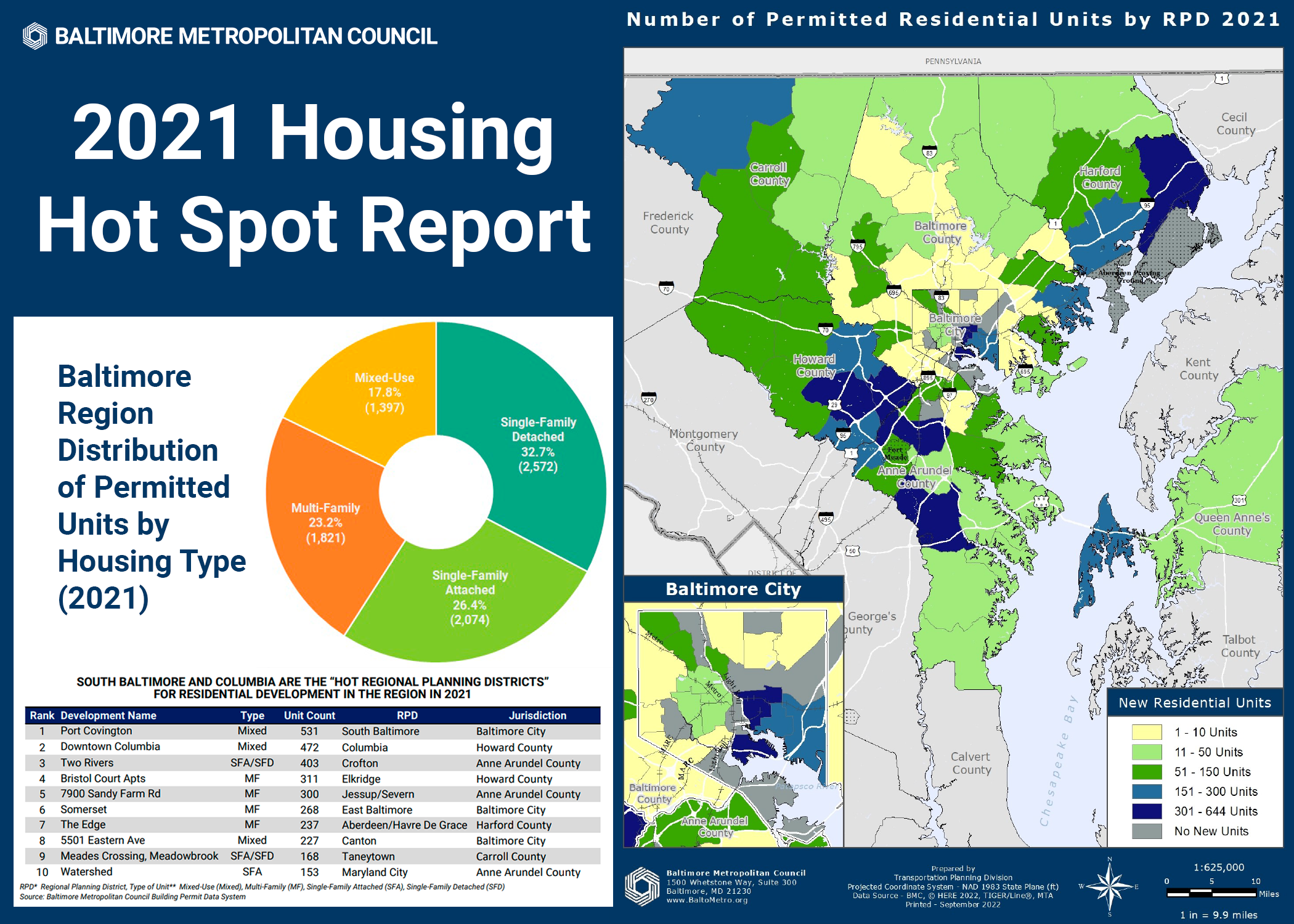
BMC compiles and maintains the region’s building permit information into a standardized database, displayed here in an interactive map. This database provides a continual record of plans for new and renovated residential and non-residential projects from all permits with an estimated construction value of $10,000 or more. This information is a leading indicator of new regional development patterns.
The latest hot spot report was released just after BMC's latest round of demographic forecasts, which project a population growth of 12.6 percent across the region by 2050. Howard County leads the jurisdictions with a projected 24.8 percent growth, followed by Harford and Anne Arundel Counties with 18.4 percent and 17.1 percent growth each. The forecasts also project growth in the number of households with similar results: Howard County leads with 34.5 percent growth, followed by Harford (23 percent) and Anne Arundel (18.4 percent).
In addition to these two projects, BMC worked with member jurisdictions to increase access to affordable housing in the region. In 2021, BMC celebrated the opening of Robinson Overlook, an affordable housing development in Columbia. Since 2015, BMC's Regional Project-Based Voucher Program has settled more than 30 families, with an additional 20 vouchers awarded in spring 2022, helping more families settle in affordable housing developments in and around Baltimore.
###
The Baltimore Metropolitan Council (BMC) works collaboratively with the chief elected officials in the region to create initiatives to improve our quality of life and economic vitality. BMC, as the Baltimore region’s council of governments, hosts the Baltimore Regional Transportation Board (BRTB), the federal metropolitan planning organization (MPO), and supports local government by coordinating efforts in a range of policy areas including emergency preparedness, housing, cooperative purchasing, environmental planning and workforce development.
BMC’s Board of Directors includes the executives of Anne Arundel, Baltimore, Harford and Howard counties, the mayor of the City of Baltimore, a member of the Carroll County and Queen Anne’s County boards of commissioners, a member of the Maryland State Senate, a member of the Maryland House of Delegates, and a gubernatorial appointee from the private sector.

BMC Brings Local Leaders to Detroit, MI for Chesapeake Connect 2022
BALTIMORE, MD (Wednesday, July 26, 2022) - The Baltimore Metropolitan Council (BMC) led its annual Chesapeake Connect trip to Detroit, Michigan from Wednesday, July 20 to Friday, July 22, bringing together leaders from across greater Baltimore to connect, reflect and learn from the experiences of a peer region.
Over 60 government, private sector and nonprofit leaders joined BMC in Detroit, with a program focused on unpacking the profound impact of Detroit’s 2013 municipal bankruptcy. Through site visits and discussions with local community leaders, BMC sought to curate an effective exploration of the innovative developments reinvigorating a great American city.
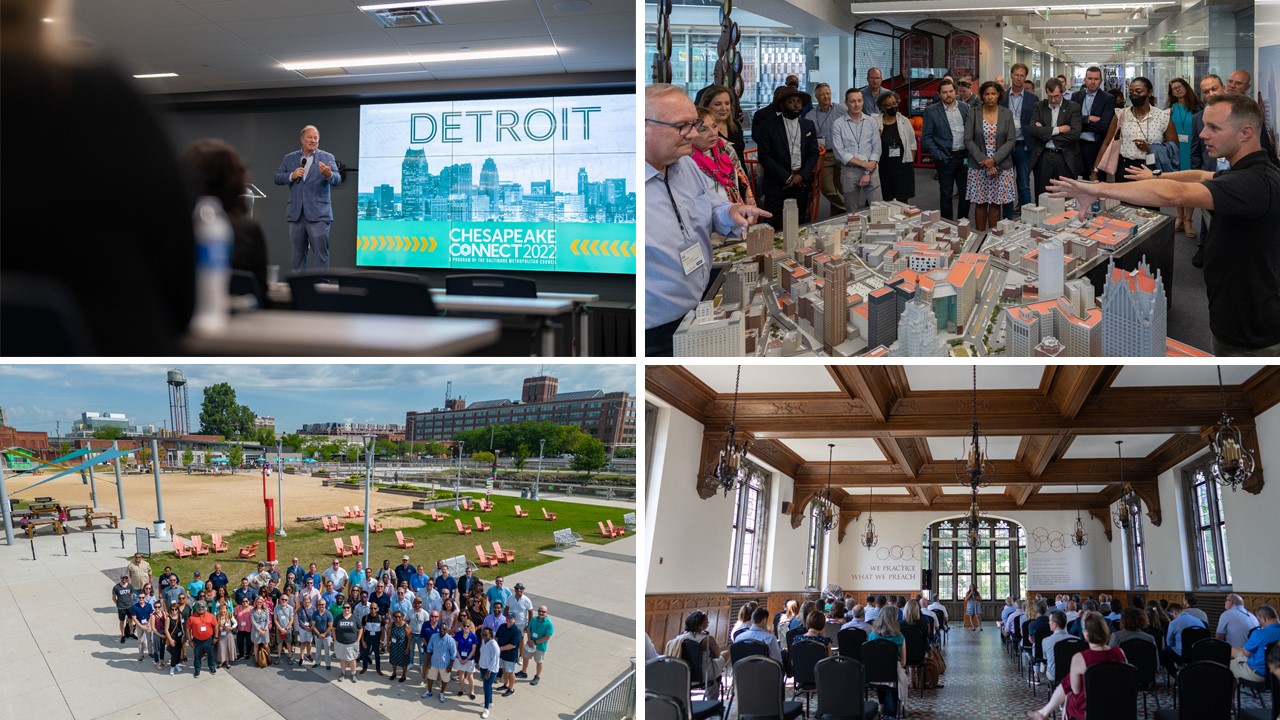
Motor City, as Detroit became known due to its place as a global hub for auto manufacturing, shares many of the challenges facing Charm City, including a declining population, historic under-investment and barriers to building wealth in communities of color. Detroit has bright minds implementing brilliant ideas to counter these challenges, and the Chesapeake Connect trip posed the question: how can we bolster similar ideas in and around Baltimore?
The trip kicked off with a visit to the Union Carpenters and Millwrights Skilled Training Center, where participants heard from Detroit Mayor Mike Duggan about his efforts to guide the city out of bankruptcy. Later that day, a tour of downtown concluded at One Campus Martius, where participants dined with the Rock Family of Companies and learned about their historic corporate and private investment in the city.
On day two, participants got a close-up view of development in Detroit’s neighborhoods, starting with the cradle-to-career campus opening at Marygrove Conservancy. That afternoon, small groups broke out to explore four industry hubs across the city. That evening, participants reconvened for dinner in the enclave of Hamtramck, hearing from Mayor Amer Ghalib and members of what is believed to be the country’s first all-Muslim city council.
For the final day, participants focused on open spaces and public waterfront development, touring the downtown Capitol Park and a five-mile pedestrian stretch of the Detroit Riverfront before a closing lunch at the Michigan Department of Natural Resources Outdoor Adventure Center.
For more details about the trip, see BMC’s Chesapeake Connect 2022 story map or peruse the Chesapeake Connect 2022 Program.
Participants will be invited to join a Chesapeake Re-Connect wrap-up event to encourage a continuing dialogue about the innovations and development strategies observed in Detroit.
Previous Chesapeake Connect trips have brought leaders from the Baltimore region together in Philadelphia, Nashville, New Orleans and Cleveland. BMC has already begun planning the Chesapeake Connect 2023 trip and will announce the destination and dates early next year.
Chesapeake Connect 2022 would not have been possible without the support of sponsors, including Mercy Medical Center, 28 Walker, BGE, Exelon, Hartman Executive Advisors, the Maryland Institute College of Art, Southway Builders, Tradepoint Atlantic, the Baltimore Community Foundation, Design Collective, Loyola University Maryland, Morris & Ritchie Associates, Ballard Spahr, the Baltimore Development Corporation, Chase Brexton Health Care, Gordian Energy Systems, Howard Hughes, Park Heights Renaissance, University of Maryland Baltimore, the University of Maryland Medical System, Web Connection, and the Annie E. Casey Foundation.
###

The Baltimore Regional Cooperative Purchasing Committee (BRCPC) recently released its 2021 Annual Report, outlining their work over the past year.
The report recaps activities of the committee including their procurement achievements in such unprecedented times, where the supply chain could not deliver essential supplies, such as N95 masks or certain food products. BRCPC was able to make these procurements, due largely to their willingness to adapt and collaborate through the committee.
In addition to these accomplishments, the Energy Board continues to be a great example of efficient and innovative government. BMC works with its member jurisdictions and the State of Maryland to leverage their collective government buying power. Savings are realized through purchasing in quantity and consolidating the administrative costs associated with procurement. Twenty-four members of the Energy Board, along with several other entities participate in the wholesale market cooperative procurements for their energy requirements.
The gross worth of BRCPC’s Energy Board is approximately $111 M for electric and natural gas commodities. The Energy Board, comprising all participating parties, is the largest BGE customer.
The BRCPC Energy Board’s primary focus is the oversight of the energy cost management and procurement programs for both electric and natural gas supply portfolios. This includes receiving, researching, and assessing energy market developments including renewable energy on an ongoing basis.
BRCPC looks forward to continued collaboration and success in 2022.
To read the full 2021 annual report, visit: https://baltometro.org/purchasing/about

The Baltimore Regional Transportation Board (BRTB) welcomes comments on its draft updated work plan and budget through Thursday, March 10, 2022.
The BRTB is scheduled to vote on the updated budget for FY 2023 on Tuesday, April 26, 2022.
What is the UPWP?
The BRTB’s Budget & Work Program is known as the Unified Planning Work Program (UPWP) for Transportation Planning. It is a federal requirement that details projects, studies and other activities to be completed by BRTB members and staff of the Baltimore Metropolitan Council (BMC).
The BRTB develops this list of regional transportation planning activities every two fiscal years. This UPWP includes an updated budget for FY 2023 of $7,370,000. UPWP funds support staff for regional planning activities with some consultant assistance.
Several of the new proposed projects for FY 2023 include:
- Safe System Approach: Support a safety culture that places safety first and foremost in road system investment decisions. To achieve a zero deaths vision, everyone must accept that fatalities and serious injuries are unacceptable and preventable.
- Thirty Percent Design for Bicycle Trails: Advance planning for a segment of the Patapsco Regional Greenway to include all steps necessary to complete what is known as thirty percent design.
- RTP LOTS Skills and Technology Support: Support the improvement and expansion of skills and access to technology for the Locally Operated Transit Systems (LOTS) in the Baltimore region.
- Expanding Coverage for Electric Vehicle Charging Stations: To support regional and equitable expansion of public light duty electric vehicle (EV) charging station infrastructure in the region.
- Considerations and Preparations for Connected and Automated Vehicles: Develop customized recommendations for the region to prepare for connected and automated vehicles.
View the FY 2023 UPWP | Read a list of Frequently Asked Questions | Watch a recorded overview
Share Your Thoughts
Public input is essential to the development of the UPWP and we encourage people to view the draft document and tell us what you think.
The public is invited to provide feedback on the updated FY 2023 budget and proposed regional transportation planning activities from Tuesday, February 8 through Thursday, March 10, 2022.
View Comments and BRTB Response
Please send all comments using one of the following options:
|
Online: |
|
|
Text: |
Text the phrase ‘2023upwp’ to the number 73224 |
|
Voicemail: |
Call toll free 855-925-2801 x 4231 and leave us a voicemail |
|
Email: |
|
|
Twitter: |
Direct Message @BaltoMetroCo or @BmoreInvolved or use the hashtag #BRTBlistens |
|
Mail: |
The Baltimore Regional Transportation Board |
To learn more about the UPWP and the proposed updated budget and projects, please view a recorded presentation.
The public may also provide feedback during the Public Comment Opportunity at the BRTB monthly meetings on February 22 or March 22 or when the BRTB votes on April 26, 2022. Due to the public health concerns presented by the Coronavirus (COVID-19), all scheduled meetings will take place virtually. Please check the calendar for an updated schedule and links to attend the virtual meetings.
The BRTB is the federally recognized metropolitan planning organization (MPO) for transportation in the region. BMC provides the BRTB with staff support.
The Baltimore Regional Transportation Board operates its programs and services without regard to race, color, or national origin in accordance with Title VI of the Civil Rights Act of 1964, and other applicable laws. Appropriate services can be provided to qualified individuals with disabilities or those in need of language assistance who submit a request at least seven days prior to a meeting. Call 410- 732-0500. Dial 7-1-1 or 800-735-2258 to initiate a TTY call through Maryland Relay. Si se necesita información de Título VI en español, llame al 410-732-0500.

The Baltimore Metropolitan Council has released its 2020 Residential Building Permit Activity Hot Spot Report. The document outlines the residential hot spots in our region in 2020.
Every new construction project and any significant improvement to an existing structure requires a building permit issued by the local government--the county or an incorporated municipality. The Baltimore Metropolitan Council tracks permits issued in all seven of its jurisdictions.
In 2020, a total of 7,689 new residential units were permitted in the Baltimore Region. This figure represents an 11% increase over the previous year. The top ten most active or “hottest” residential developments, in terms of the number of units permitted, accounted for 34.7% of all new units in the region. The top-10 residential hot spots developments are spread across five jurisdictions: Baltimore City, Anne Arundel County, Baltimore County, Harford County and Howard County. Nearly 71% of the 2,670 residential units permitted in the region’s hot spots are multi-family or mixed-use. Just over 29% are single family units.
The 2020 Residential Hot Spot Report also outlines the top five residential developments in each county.
View the 2020 Residential Building Permit Activity Hot Spot Report:
About BMC’s Building Permit Data
The Baltimore Metropolitan Council compiles and maintains the region’s building permit information into a standardized database. This database provides a continual record of plans for new and renovated residential and non-residential projects from all permits with an estimated construction value of $10,000 or more. The BMC staff uses this information as a leading indicator of new regional development patterns. Our Building Permits Dashboards summarize this data and are made available to the public on the BMC website.

The Baltimore Metropolitan Council led its annual Chesapeake Connect trip, in Philadelphia, Pennsylvania Wednesday, October 13 - Thursday, October 15, 2021. Chesapeake Connect brings leaders from across Baltimore region to a peer region for a three-day learning experience.
Over 60 leaders from across the region traveled by train from Baltimore Penn Station to Philadelphia’s 30th Street Station for the event. The agenda included presentations by Philadelphia leaders, tours of parks and public assets, and visits to non-profits and development sites with lessons for the Baltimore region.
The first day of the program focused on West Philadelphia’s University City, and the decades of cooperative investment by the City of Philadelphia and anchor institutions like the University of Pennsylvania and Drexel University. The day ended with a visit to the Enterprise Center, one of the most innovative and successful urban entrepreneurship centers in the entire country.
Our second day started with executive briefings on Philadelphia’s efforts to equitable invest in broadband access and aging city assets. Those briefings were followed by a tour of Dillworth Park, a privately managed park just outside of Philadelphia’s historic City Hall. The group then split into small groups to visit neighborhood development sites, groundbreaking urban trails, a nationally recognized public art effort and the Navy Yard, one of the largest redevelopment efforts on the east coast.
Our final day in Philadelphia began with a discussion of regionalism with leaders from the Delaware Valley Regional Planning Commission and the Southeast Pennsylvania Transportation Authority. The program closed with a tour of FDR Park, Philadelphia’s only Olmstead park that is currently in the midst of a strategic redesign to better meet the needs of a growing and diverse immigrant community in South Philadelphia.
The City of Brotherly Love, shares many of the same strengths and challenges of the Baltimore Metropolitan area. Both places boast of vibrant cultural and university districts, some of the world’s leading research institutions and balance of urban living with attractive and desirable suburban communities.
However, both places struggle with the socio-economic impacts of redlining, a crisis of substance abuse, and deep rooted economic, health, and technology based disparities made clearer by the pandemic.
Like Baltimore, Philadelphia is a city of neighborhoods, and every neighborhood story is unique. Over the three day event, attendees heard first hand from Philadelphia’s leaders and decision makers about the wins, pitfalls and works in progress that define the Philadelphia region.
The 2021 trip came after the necessary cancellation of the 2020 Chesapeake Connect trip, slated for Minneapolis, Minnesota. In response to the worldwide pandemic and out of an abundance of caution, BMC repurposed the trip into the “Chesapeake Connect Podcast.” The podcast focuses on a deeper exploration of the Baltimore region, through conversations with elected officials, non-profits, local companies and WYPR’s Tom Hall.
Past trips have included Nashville, TN, New Orleans, LA , and Cleveland, OH.
BMC will begin planning for Chesapeake Connect 2022 soon and will announce a destination and dates for the trip next spring. BMC is hopeful for another successful in person event.
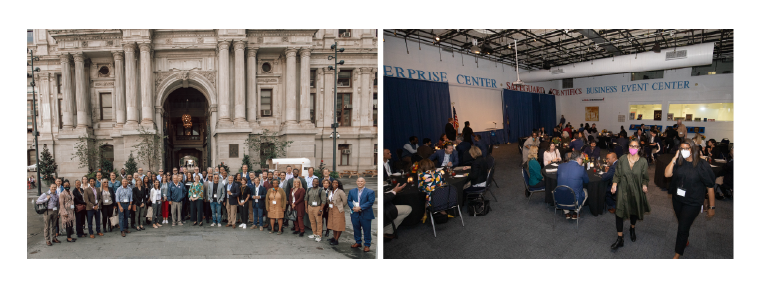 |
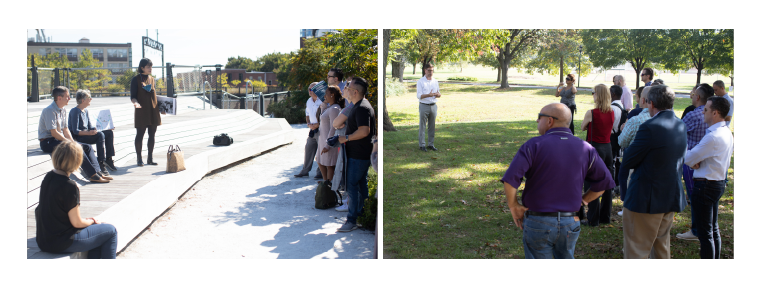 |

The Association of Metropolitan Planning Organizations (AMPO) held their annual conference from Tuesday, October 5th through Friday, October 8th, 2021. The conference attracted over 300 attendees from 80 metropolitan areas.
The BRTB participated in many ways throughout the conference. BRTB Chair, Ramond Robinson, moderated a session on Transit Planning and Travel Behavior, where presenters discussed the Regional Transportation Commission’s (Southern Nevada) On-Board Mobility Plan process and Metropolitan Washington Council of Government’s (MWCOG) strategies on how to encourage commuters to reconsider transportation options and habits.
BRTB Vice Chair, D’Andrea Walker, moderated a session on Transit, where presenters discussed the Fredericksburg Area MPO’s attempt to understand mode choice and MWCOG shared how they are advancing aspirational transit projects.
BMC Transportation Director, Todd Lang, moderated a panel on Activity Based Modeling, exploring AMPO’s ActivitySim consortium model and project progress to date, and more.
BMC Assistant Transportation Director, Regina Aris, moderated sessions on Partnerships and Core Products featuring Memphis Area MPO and the Denver Regional Council of Governments. Presenters shared best practices for Transportation Improvement Program (TIP) planning, programming, project tracking, coordination and using scenario planning for their long-range transportation plan update.
BMC’s Bala Akundi presented on implementing a Safe Systems Approach. This panel discussion explored opportunities for MPO’s to integrate a new FHWA framework, the Safe System Approach.
The BRTB was largely engaged in sessions, participating in many panel discussions while sharing strategies, experiences, learnings and challenges. Our staff and board took advantage of the opportunity to, yet again, be in a space where we could learn from peer MPOs and provide guidance on our unique methodologies that have brought us success over the last year.
Mr. Lang is in the final year of his elected position on the AMPO Board of Directors and with the American Public Transportation Association (APTA) Metropolitan Planning Subcommittee.
The AMPO is a resource for MPOs throughout the country, providing a platform for training, education, case studies, networking, peer-exchange and more.
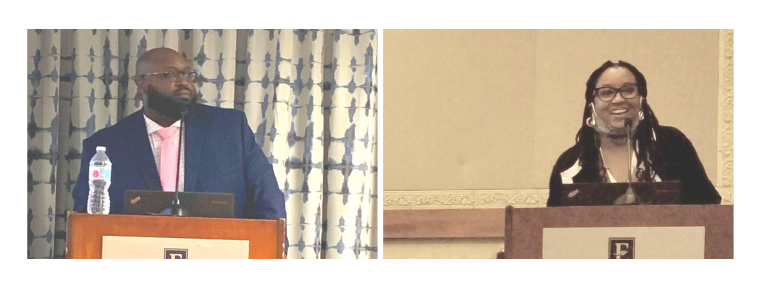 |
